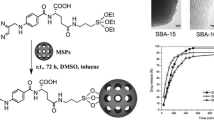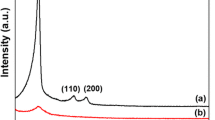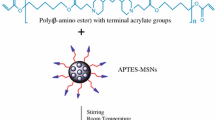Abstract
In recent years, nanomaterials with properties such as biocompatibility, high specific surface area, and narrow pore distribution have been extensively studied for the treatment of cancer patients. These materials can be loaded with anti-tumor agents to promote a targeted delivery of drugs, reducing the occurrence of side effects common in conventional treatments. However, the ideal characteristics for biomedical applications are not often found combined in a single material, causing the need for the creation of systems composed of more phases to achieve the best material for such applications. Mesoporous silica nanoparticles are promising materials for this purpose, considering the possibility to incorporate organic and inorganic phases into this matrix, such as sensitive polymers, hydroxyapatite (HA) nanoparticles, and rare-earth elements, creating a theranostic material—a single hybrid compound with multifunctionality and capable of performing diagnostic and treatment functions simultaneously. In this study, we report the production of a europium-doped mesoporous silica/hydroxyapatite nanocomposite functionalized with the pH-sensitive polymer poly(methacrylic acid)—P(MAA). The samples were characterized by XRD, FTIR, CHN, TGA, SEM, TEM, XRF, N2 adsorption, and PL techniques. Incorporation and release assays using the antitumor drug methotrexate were performed to evaluate the potential use of these materials as drug carriers in cancer therapy. The results show the photoluminescent potential of these systems, due to the europium doping, and the pH-dependent response in drug release, due to the P(MAA) functionalization. In conclusion, data from this work show that these hybrid nanocomposites exhibit adequate characteristics to be used as a drug delivery platform.











Similar content being viewed by others
References
Adamiano A, Iafisco M, Sandri M, Basini M, Arosio P, Canu T, Sitia G, Esposito A, Iannotti V, Ausanio G, Fragogeorgi E, Rouchota M, Loudos G, Lascialfari A, Tampieri A (2018) On the use of superparamagnetic hydroxyapatite nanoparticles as an agent for magnetic and nuclear in vivo imaging. Acta Biomater 73:458–469. https://doi.org/10.1016/j.actbio.2018.04.040
Aguilar MR, San Román J (2007) Introduction to smart polymers and their applications. Smart Polymers and their Applications. Elsevier, In, pp 1–11
Al-Shehri BM, Khder A-R, Ashour SS et al (2019) Effect of europium loading on the photoluminescence property of europium incorporated 3D-Mesoporous silica. J Non-Cryst Solids 515:68–74. https://doi.org/10.1016/j.jnoncrysol.2019.04.007
Aminian A, Solati-Hashjin M, Samadikuchaksaraei A, Bakhshi F, Gorjipour F, Farzadi A, Moztarzadeh F, Schmücker M (2011) Synthesis of silicon-substituted hydroxyapatite by a hydrothermal method with two different phosphorous sources. Ceram Int 37:1219–1229. https://doi.org/10.1016/j.ceramint.2010.11.044
Andersson J, Areva S, Spliethoff B, Lindén M (2005) Sol–gel synthesis of a multifunctional, hierarchically porous silica/apatite composite. Biomaterials 26:6827–6835. https://doi.org/10.1016/j.biomaterials.2005.05.002
Andrade GF, Gomide VS, da Silva Júnior AC, Goes AM, de Sousa EMB (2014) An in situ synthesis of mesoporous SBA-16/hydroxyapatite for ciprofloxacin release: in vitro stability and cytocompatibility studies. J Mater Sci Mater Med 25:2527–2540. https://doi.org/10.1007/s10856-014-5273-6
Apostolos RCR, Andrade GF, Silva WM, Assis Gomes D, Miranda MC, Sousa EMB (2019) Hybrid polymeric systems of mesoporous silica/hydroxyapatite nanoparticles applied as antitumor drug delivery platform. Int J Appl Ceram Technol 16:1836–1849. https://doi.org/10.1111/ijac.13231
Aquib M, Farooq MA, Banerjee P, Akhtar F, Filli MS, Boakye-Yiadom KO, Kesse S, Raza F, Maviah MBJ, Mavlyanova R, Wang B (2019) Targeted and stimuli–responsive mesoporous silica nanoparticles for drug delivery and theranostic use. J Biomed Mater Res Part A 107:2643–2666. https://doi.org/10.1002/jbm.a.36770
Argyo C, Weiss V, Bräuchle C, Bein T (2014) Multifunctional mesoporous silica nanoparticles as a universal platform for drug delivery. Chem Mater 26:435–451. https://doi.org/10.1021/cm402592t
Asefa T, Tao Z (2012) Biocompatibility of mesoporous silica nanoparticles. Chem Res Toxicol 25:2265–2284. https://doi.org/10.1021/tx300166u
Barua S, Mitragotri S (2014) Challenges associated with penetration of nanoparticles across cell and tissue barriers: a review of current status and future prospects. Nano Today 9:223–243. https://doi.org/10.1016/j.nantod.2014.04.008
Bharti C, Gulati N, Nagaich U, Pal A (2015) Mesoporous silica nanoparticles in target drug delivery system: A review. Int J Pharm Investig 5:124. https://doi.org/10.4103/2230-973X.160844
Binnemans K (2015) Interpretation of europium(III) spectra. Coord Chem Rev 295:1–45. https://doi.org/10.1016/j.ccr.2015.02.015
Biswas RK, Khan P, Mukherjee S, Mukhopadhyay AK, Ghosh J, Muraleedharan K (2018) Study of short range structure of amorphous Silica from PDF using Ag radiation in laboratory XRD system, RAMAN and NEXAFS. J Non-Cryst Solids 488:1–9. https://doi.org/10.1016/j.jnoncrysol.2018.02.037
Brigger I, Dubernet C, Couvreur P (2012) Nanoparticles in cancer therapy and diagnosis. Adv Drug Deliv Rev 64:24–36. https://doi.org/10.1016/j.addr.2012.09.006
Carter CB, Norton MG (2013) Ceramic materials, second. Springer New York, New York, NY
Chakraborty M, Dasgupta S, Sengupta S, Chakraborty J, Ghosh S, Ghosh J, Mitra MK, Mishra A, Mandal TK, Basu D (2012) A facile synthetic strategy for Mg–Al layered double hydroxide material as nanocarrier for methotrexate. Ceram Int 38:941–949. https://doi.org/10.1016/j.ceramint.2011.08.014
Chen M-H, Yoshioka T, Ikoma T, Hanagata N, Lin FH, Tanaka J (2014) Photoluminescence and doping mechanism of theranostic Eu 3+ /Fe 3+ dual-doped hydroxyapatite nanoparticles. Sci Technol Adv Mater 15:055005. https://doi.org/10.1088/1468-6996/15/5/055005
CHEN L, CHEN T, CAO J, LIU BL, SHAO CS, ZHOU KC, ZHANG D (2018) Effect of Tb/Mg doping on composition and physical properties of hydroxyapatite nanoparticles for gene vector application. Trans Nonferrous Met Soc China 28:125–136. https://doi.org/10.1016/S1003-6326(18)64645-X
Ciobanu CS, Iconaru SL, Massuyeau F, Constantin LV, Costescu A, Predoi D (2012) Synthesis, structure, and luminescent properties of europium-doped hydroxyapatite nanocrystalline powders. J Nanomater 2012:1–9. https://doi.org/10.1155/2012/942801
Cipreste MF, Peres AM, Cotta AAC, Aragón FH, Antunes AM, Leal AS, Macedo WAA, de Sousa EMB (2016) Synthesis and characterization of 159 Gd-doped hydroxyapatite nanorods for bioapplications as theranostic systems. Mater Chem Phys 181:301–311. https://doi.org/10.1016/j.matchemphys.2016.06.063
Cipreste MF, de Rezende MR, Hneda ML et al (2018) Functionalized-radiolabeled hydroxyapatite/tenorite nanoparticles as theranostic agents for osteosarcoma. Ceram Int 44:17800–17811. https://doi.org/10.1016/j.ceramint.2018.06.248
Colilla M, González B, Vallet-Regí M (2013) Mesoporous silica nanoparticles for the design of smart delivery nanodevices. Biomater Sci 1:114–134. https://doi.org/10.1039/C2BM00085G
Davies G-L, O’Brien J, Gun’ko YK (2017) Rare earth doped silica nanoparticles via thermolysis of a single source metallasilsesquioxane precursor. Sci Rep 7:45862. https://doi.org/10.1038/srep45862
de Rezende MR, Andrade GF, Cipreste MF, Miranda MC, Gomes DA, de Barros Correia Menezes MÂ, de Sousa EMB (2019) 89 Sr-doped hydroxyapatite nanoparticles as a potential therapeutic agent for bone tumors. Int J Appl Ceram Technol 16:1904–1919. https://doi.org/10.1111/ijac.13262
Domingues ZR, Cortés ME, Gomes TA, Diniz HF, Freitas CS, Gomes JB, Faria AMC, Sinisterra RD (2004) Bioactive glass as a drug delivery system of tetracycline and tetracycline associated with β-cyclodextrin. Biomaterials 25:327–333. https://doi.org/10.1016/S0142-9612(03)00524-6
Du C, Ma L, Xu Y, Li W (1997) Synthesis and fluorescent properties of europium-polymer complexes containing naphthoate and 1.10-phenanthroline ligands. J Appl Polym Sci 66:1405–1410. https://doi.org/10.1002/(SICI)1097-4628(19971114)66:7<1405::AID-APP19>3.0.CO;2-0
Enrichi F, Riccò R, Parma A et al (2008) Synthesis and characterization of monodisperse Eu-doped luminescent silica nanospheres for biological applications. Biophotonics Photonic Solut Better Heal Care 6991:69912E. https://doi.org/10.1117/12.781504
Escudero A, Calvo ME, Rivera-Fernández S, de la Fuente JM, Ocaña M (2013) Microwave-assisted synthesis of biocompatible europium-doped calcium hydroxyapatite and fluoroapatite luminescent nanospindles functionalized with poly(acrylic acid). Langmuir 29:1985–1994. https://doi.org/10.1021/la304534f
Frank-Kamenetskaya OV (2008) Structure, chemistry and synthesis of carbonate apatites — the main components of dental and bone tissues. In: Minerals as Advanced Materials I. Springer, Berlin Heidelberg, Berlin, Heidelberg, pp 241–252
Frasnelli M, Cristofaro F, Sglavo VM, Dirè S, Callone E, Ceccato R, Bruni G, Cornaglia AI, Visai L (2017) Synthesis and characterization of strontium-substituted hydroxyapatite nanoparticles for bone regeneration. Mater Sci Eng C 71:653–662. https://doi.org/10.1016/j.msec.2016.10.047
Freitas LB d O, Corgosinho L d M, Faria JAQA et al (2017) Multifunctional mesoporous silica nanoparticles for cancer-targeted, controlled drug delivery and imaging. Microporous Mesoporous Mater 242:271–283. https://doi.org/10.1016/j.micromeso.2017.01.036
Han Y, Wang X, Dai H, Li S (2013) Synthesis and luminescence of Eu3+ doped hydroxyapatite nanocrystallines: effects of calcinations and Eu3+ content. J Lumin 135:281–287. https://doi.org/10.1016/j.jlumin.2012.09.029
Hoffmann F, Cornelius M, Morell J, Fröba M (2006) Silica-based mesoporous organic–inorganic hybrid materials. Angew Chemie Int Ed 45:3216–3251. https://doi.org/10.1002/anie.200503075
Ignjatović NL, Mančić L, Vuković M, Stojanović Z, Nikolić MG, Škapin S, Jovanović S, Veselinović L, Uskoković V, Lazić S, Marković S, Lazarević MM, Uskoković DP (2019) Rare-earth (Gd3+,Yb3+/Tm3+, Eu3+) co-doped hydroxyapatite as magnetic, up-conversion and down-conversion materials for multimodal imaging. Sci Rep 9:16305. https://doi.org/10.1038/s41598-019-52885-0
Jadhav SA (2014) Incredible pace of research on mesoporous silica nanoparticles. Inorg Chem Front 1:735–739. https://doi.org/10.1039/C4QI00118D
Kamachi Y, Bastakoti BP, Alshehri SM, Miyamoto N, Nakato T, Yamauchi Y (2016) Thermo-responsive hydrogels containing mesoporous silica toward controlled and sustainable releases. Mater Lett 168:176–179. https://doi.org/10.1016/j.matlet.2015.12.132
Kataoka T, Shiba K, Tagaya M (2018) An investigation into nanohybrid states of europium (III) complex with hydroxyapatite nanocrystals. Opt Mater (Amst) 84:252–258. https://doi.org/10.1016/j.optmat.2018.07.014
Kim Y, Song BG, Kim SR, Kim KJ (2005) Drug loaded porous hydroxyapatite and its in vitro release. Key Eng Mater 284–286:423–426. https://doi.org/10.4028/www.scientific.net/KEM.284-286.423
LeGeros RZ, Trautz OR, Klein E, LeGeros JP (1969) Two types of carbonate substitution in the apatite structure. Experientia 25:5–7. https://doi.org/10.1007/BF01903856
Lin L, Chow KL, Leng Y (2009) Study of hydroxyapatite osteoinductivity with an osteogenic differentiation of mesenchymal stem cells. J Biomed Mater Res Part A 89A:326–335. https://doi.org/10.1002/jbm.a.31994
Lin Y-S, Hurley KR, Haynes CL (2012) Critical considerations in the biomedical use of mesoporous silica nanoparticles. J Phys Chem Lett 3:364–374. https://doi.org/10.1021/jz2013837
Martin P, Carlot G, Chevarier A, den-Auwer C, Panczer G (1999) Mechanisms involved in thermal diffusion of rare earth elements in apatite. J Nucl Mater 275:268–276. https://doi.org/10.1016/S0022-3115(99)00126-9
Mir M, Leite FL, Herrmann Junior PS d P et al (2012) XRD, AFM, IR and TGA study of nanostructured hydroxyapatite. Mater Res 15:622–627. https://doi.org/10.1590/S1516-14392012005000069
Narayan R, Nayak U, Raichur A, Garg S (2018) Mesoporous silica nanoparticles: a comprehensive review on synthesis and recent advances. Pharmaceutics 10:118. https://doi.org/10.3390/pharmaceutics10030118
Neacsu IA, Stoica AE, Vasile BS, Andronescu E (2019) Luminescent hydroxyapatite doped with rare earth elements for biomedical applications. Nanomaterials 9:239. https://doi.org/10.3390/nano9020239
Ngoune R, Peters A, von Elverfeldt D, Winkler K, Pütz G (2016) Accumulating nanoparticles by EPR: a route of no return. J Control Release 238:58–70. https://doi.org/10.1016/j.jconrel.2016.07.028
Nishide H, Izushi T, Yoshioka N, Tsuchida E (1985) Complexation of europium ion with poly(methacrylic acid)s and fluorescent property of the complexes. Polym Bull 14:387–392. https://doi.org/10.1007/BF00263452
Pai S, Kini MS, Selvaraj R (2019) A review on adsorptive removal of dyes from wastewater by hydroxyapatite nanocomposites. Environ Sci Pollut Res. https://doi.org/10.1007/s11356-019-07319-9
Park M, Komarneni S (1998) Stepwise functionalization of mesoporous crystalline silica materials. Microporous Mesoporous Mater 25:75–80. https://doi.org/10.1016/S1387-1811(98)00173-5
Rakovan J, Reeder RJ (1996) Intracrystalline rare earth element distributions in apatite: surface structural influences on incorporation during growth. Geochim Cosmochim Acta 60:4435–4445. https://doi.org/10.1016/S0016-7037(96)00244-X
Rawat P, Ahmad I, Thomas SC, Pandey S, Vohora D, Gupta S, Ahmad FJ, Talegaonkar S (2016) Revisiting bone targeting potential of novel hydroxyapatite based surface modified PLGA nanoparticles of risedronate: pharmacokinetic and biochemical assessment. Int J Pharm 506:253–261. https://doi.org/10.1016/j.ijpharm.2016.04.049
Sangeetha K, Ashok M, Girija EK, Vidhya G, Vasugi G (2018) Strontium and ciprofloxacin modified hydroxyapatites as functional grafts for bone prostheses. Ceram Int 44:13782–13789. https://doi.org/10.1016/j.ceramint.2018.04.221
Shi M, Xia L, Chen Z, Lv F, Zhu H, Wei F, Han S, Chang J, Xiao Y, Wu C (2017) Europium-doped mesoporous silica nanosphere as an immune-modulating osteogenesis/angiogenesis agent. Biomaterials 144:176–187. https://doi.org/10.1016/j.biomaterials.2017.08.027
Silva FRO, de Lima NB, Bressiani AHA, Courrol LC, Gomes L (2015) Synthesis, characterization and luminescence properties of Eu3+−doped hydroxyapatite nanocrystal and the thermal treatment effects. Opt Mater (Amst) 47:135–142. https://doi.org/10.1016/j.optmat.2015.07.006
Silva WM d, Monteiro GAA, Gastelois PL et al (2018) Efficient sensitive polymer-grafted boron nitride nanotubes by microwave-assisted process. Nano-Structures & Nano-Objects 15:186–196. https://doi.org/10.1016/j.nanoso.2017.09.014
Sing KSW (1985) Reporting physisorption data for gas/solid systems with special reference to the determination of surface area and porosity (recommendations 1984). Pure Appl Chem 57:603–619. https://doi.org/10.1351/pac198557040603
Sistanipour E, Meshkini A, Oveisi H (2018) Catechin-conjugated mesoporous hydroxyapatite nanoparticle: a novel nano-antioxidant with enhanced osteogenic property. Colloids Surfaces B Biointerfaces 169:329–339. https://doi.org/10.1016/j.colsurfb.2018.05.046
Sousa RG, Prior-Cabanillas A, Quijada-Garrido I, Barrales-Rienda JM (2005) Dependence of copolymer composition, swelling history, and drug concentration on the loading of diltiazem hydrochloride (DIL.HCl) into poly[(N-isopropylacrylamide)-co-(methacrylic acid)] hydrogels and its release behaviour from hydrogel slabs. J Control Release 102:595–606. https://doi.org/10.1016/j.jconrel.2004.10.025
Sousa A, Souza KC, Sousa EMB (2008) Mesoporous silica/apatite nanocomposite: special synthesis route to control local drug delivery. Acta Biomater 4:671–679. https://doi.org/10.1016/j.actbio.2007.11.003
Sowjanya M, Debnath S, Lavanya P et al (2017) Polymers used in the Designing of Controlled Drug Delivery System. Res J Pharm Technol 10:903. https://doi.org/10.5958/0974-360X.2017.00168.8
Subbiah R, Veerapandian M, Yun SK (2010) Nanoparticles: functionalization and multifunctional applications in biomedical sciences. Curr Med Chem 17:4559–4577. https://doi.org/10.2174/092986710794183024
Syamchand SS, Sony G (2015) Europium enabled luminescent nanoparticles for biomedical applications. J Lumin 165:190–215. https://doi.org/10.1016/j.jlumin.2015.04.042
Tesch A, Wenisch C, Herrmann K-H, Reichenbach JR, Warncke P, Fischer D, Müller FA (2017) Luminomagnetic Eu3+− and Dy3+−doped hydroxyapatite for multimodal imaging. Mater Sci Eng C 81:422–431. https://doi.org/10.1016/j.msec.2017.08.032
Torchilin V (2011) Tumor delivery of macromolecular drugs based on the EPR effect. Adv Drug Deliv Rev 63:131–135. https://doi.org/10.1016/j.addr.2010.03.011
Verma G, Barick KC, Manoj N, Sahu AK, Hassan PA (2013) Rod-like micelle templated synthesis of porous hydroxyapatite. Ceram Int 39:8995–9002. https://doi.org/10.1016/j.ceramint.2013.04.100
Wang J, Li G (2015) Mechanisms of methotrexate resistance in osteosarcoma cell lines and strategies for overcoming this resistance. Oncol Lett 9:940–944. https://doi.org/10.3892/ol.2014.2773
Wei M, Gao Y, Li X, Serpe MJ (2017) Stimuli-responsive polymers and their applications. Polym Chem 8:127–143. https://doi.org/10.1039/C6PY01585A
Yang P, Quan Z, Li C, Kang X, Lian H, Lin J (2008) Bioactive, luminescent and mesoporous europium-doped hydroxyapatite as a drug carrier. Biomaterials 29:4341–4347. https://doi.org/10.1016/j.biomaterials.2008.07.042
Yang J, Sandoval S, Alfaro JG, Aschemeyer S, Liberman A, Martin DT, Makale M, Kummel AC, Trogler WC (2011) Red-luminescent europium (III) doped silica nanoshells: synthesis, characterization, and their interaction with HeLa cells. J Biomed Opt 16:066012. https://doi.org/10.1117/1.3593003
Yousefpour M, Taherian Z (2013) The effects of ageing time on the microstructure and properties of mesoporous silica-hydroxyapatite nanocomposite. Superlattice Microst 54:78–86. https://doi.org/10.1016/j.spmi.2012.11.002
Zeng G, Liu M, Heng C, Huang Q, Mao L, Huang H, Hui J, Deng F, Zhang X, Wei Y (2017) Surface polyPEGylation of Eu3+ doped luminescent hydroxyapatite nanorods through the combination of ligand exchange and metal free surface initiated atom transfer radical polymerization. Appl Surf Sci 399:499–505. https://doi.org/10.1016/j.apsusc.2016.12.107
Zhang C, Li C, Huang S, Hou Z, Cheng Z, Yang P, Peng C, Lin J (2010a) Self-activated luminescent and mesoporous strontium hydroxyapatite nanorods for drug delivery. Biomaterials 31:3374–3383. https://doi.org/10.1016/j.biomaterials.2010.01.044
Zhang X, Lin Y, Gillies RJ (2010b) Tumor pH and its measurement. J Nucl Med 51:1167–1170. https://doi.org/10.2967/jnumed.109.068981
Zhang L, Zhang M, Zhou L, Han Q, Chen X, Li S, Li L, Su Z, Wang C (2018) Dual drug delivery and sequential release by amphiphilic Janus nanoparticles for liver cancer theranostics. Biomaterials 181:113–125. https://doi.org/10.1016/j.biomaterials.2018.07.060
Acknowledgments
The authors would like to thank the Microscopy Center–UFMG for technical support.
Funding
This research was supported by the Fundação de Amparo à Pesquisa do Estado de Minas Gerais—FAPEMIG (Grants PPM-00026-18), Conselho Nacional de Desenvolvimento Científico e Tecnológico—CNPq (Grants 304466/2018-2), and Coordenação de Aperfeiçoamento de Pessoal de Nível Superior – CAPES.
Author information
Authors and Affiliations
Corresponding author
Ethics declarations
Conflict of interest
The authors declare that they have no conflict of interest.
Additional information
Publisher’s note
Springer Nature remains neutral with regard to jurisdictional claims in published maps and institutional affiliations.
Rights and permissions
About this article
Cite this article
dos Apostolos, R.C.R., Cipreste, M.F., de Sousa, R.G. et al. Multifunctional hybrid nanosystems based on mesoporous silica and hydroxyapatite nanoparticles applied as potential nanocarriers for theranostic applications. J Nanopart Res 22, 368 (2020). https://doi.org/10.1007/s11051-020-05105-0
Received:
Accepted:
Published:
DOI: https://doi.org/10.1007/s11051-020-05105-0




